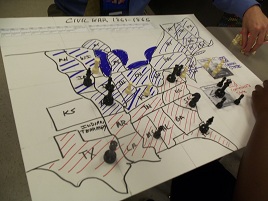|
|
Rules and Objectives
The rules were intended to be simple, yet mirror the advantages and disadvantages faced by the North and South. Objective: Union Player: Capture the Confederate capital (Richmond, VA). Confederate Player: Drag the game out at least eight "years" or capture Washington D.C. Setup Union player starts with 30 pieces off the board, the Confederate player starts with 20 pieces off the board. Each side puts ten armies on the board, four armies on the square for its capital, and the remaining six anywhere in "home" territory. Sequence of Play The game is turn based. The Union player moves first, followed by the Confederate player. Each player adds one new army to the board in a "home" state which has no enemy pieces in it. Moving and Fighting with Armies Each turn a player can move one army. An army may move into any adjacent state, or into any city in the state in which it is located. For example, an army in Maryland can move into the city of Washington D.C., but an army in Virginia has to move into Maryland before moving into the city of Washington, D.C. If an enemy army exists in the location into which a piece is moving, an enemy army is removed from the board. An army can attack (remove an enemy army from the board) without moving during its turn if both pieces start the turn in the same city or state. Special Situations The game assumes there are two conditions which would permit the Confederacy to win: The war would go on long enough for Lincoln to lose an election. The rules also allow for the hypothetical situation in which Great Britain diplomatically recognized the Confederacy. In this scenario, the South would recieve exta armies. |
   |
Back | Next: What Went Right
 Civil War Board Game
Civil War Board Game 